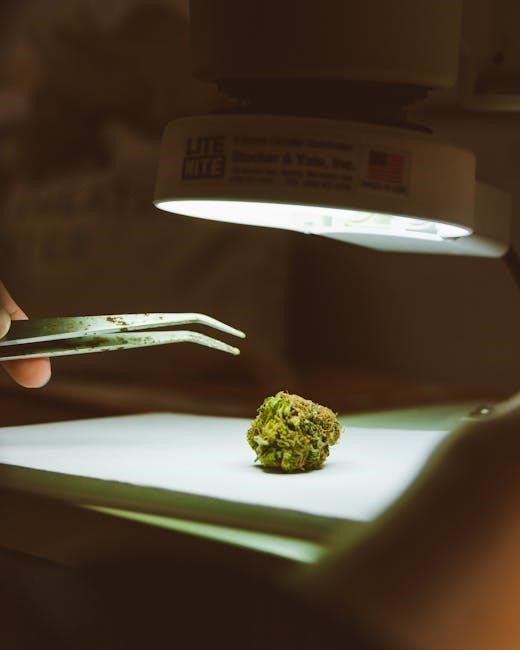The Tangie strain is renowned for its vibrant tangerine flavor, primarily driven by the terpene limonene, which contributes bright citrus and zesty notes. This unique profile, enhanced by other terpenes like myrcene and pinene, creates a refreshing and aromatic experience, making Tangie a standout strain for citrus lovers.

Overview of the Tangie Strain
The Tangie strain is a popular Sativa-dominant cannabis hybrid, known for its distinctive tangerine flavor and aroma. Created by crossing California Orange with a Skunk hybrid, Tangie has gained widespread acclaim for its vibrant citrus profile and uplifting effects. Its flavor is often described as zesty and refreshing, with a sharp citrus bite that is balanced by subtle earthy undertones. The strain has been used to create numerous Sativa hybrids, further solidifying its reputation in the cannabis community. Tangie’s unique terpene profile, particularly its high concentration of limonene, contributes to its bright, citrus-forward characteristics, making it a favorite among both enthusiasts and breeders. This strain is celebrated for its ability to deliver an invigorating and euphoric experience, while also offering a nuanced sensory journey.
Importance of Terpenes in Cannabis Flavor and Aroma
Terpenes are organic compounds found in cannabis, responsible for its diverse flavor and aroma profiles. These molecules interact with cannabinoids to enhance the plant’s sensory and therapeutic properties. In strains like Tangie, terpenes play a crucial role in creating the distinctive tangerine flavor and citrusy aroma. By influencing how cannabinoids bind to receptors, terpenes also contribute to the strain’s effects. The synergy between multiple terpenes amplifies their individual benefits, offering a more complex and enjoyable experience. This harmonious balance of terpenes is what makes Tangie’s profile so unique, showcasing the importance of terpenes in shaping the cannabis experience.

Key Terpenes Responsible for the Tangerine Flavor in Tangie
The tangerine flavor in Tangie is primarily driven by limonene, with contributions from myrcene, beta-caryophyllene, alpha-pinene, and terpinolene, creating a vibrant citrus and aromatic profile.
Limonene: The Primary Contributor to Citrus Notes
Limonene is the dominant terpene in Tangie, responsible for its signature citrus aroma and flavor. Known for its zesty, lemon-like notes, limonene creates a bright, uplifting sensory experience. This terpene is highly concentrated in Tangie, giving it a distinct tangerine taste that stands out among other strains. Limonene’s citrusy profile is not only pleasing to the palate but also contributes to the strain’s energizing and mood-enhancing effects. Its presence elevates the overall aromatic complexity, making Tangie a favorite for those who appreciate bold, citrus-forward flavors in their cannabis experience.
Myrcene: Adding Earthy and Musky Undertones
Myrcene is a prevalent terpene in Tangie, contributing earthy and musky undertones that balance its bright citrus notes. Found in hops and mangoes, myrcene adds depth to the strain’s flavor profile, introducing hints of cloves and herbal undertones. This terpene is known for its calming and relaxing properties, which complement the energizing effects of limonene. Myrcene’s earthiness grounds the citrus-forward aroma, creating a harmonious blend that enhances the overall sensory experience. Its presence also plays a role in modulating the strain’s effects, offering a soothing contrast to the uplifting qualities of other terpenes. Myrcene’s influence makes Tangie a well-rounded strain with a complex and engaging flavor profile.
Beta-Caryophyllene: Providing Spicy and Herbal Flavors

Beta-Caryophyllene is a key terpene in Tangie, adding spicy and herbal undertones to its citrus-forward profile. Known for its peppery and woody notes, this terpene enhances the strain’s complexity by introducing a subtle warmth. Beta-Caryophyllene is also recognized for its potential therapeutic benefits, including anti-inflammatory properties, which may contribute to the strain’s relaxing effects. Its spicy undertones balance the bright, zesty tangerine flavor, creating a well-rounded sensory experience. This terpene’s presence not only deepens the flavor profile but also complements the uplifting qualities of other terpenes, offering a harmonious blend of spice and citrus that sets Tangie apart from other strains.
Alpha-Pinene: Contributing Piney and Fresh Notes
Alpha-Pinene is a terpene in Tangie that adds piney and fresh notes, complementing the strain’s citrus profile. Known for its crisp, invigorating aroma, Alpha-Pinene enhances the overall sensory experience by introducing a clean, earthy undertone. This terpene is also recognized for its potential to reduce anxiety and improve focus, contributing to Tangie’s uplifting effects. Its piney freshness balances the zesty tangerine flavor, creating a harmonious blend of citrus and earth. Alpha-Pinene’s presence in Tangie’s terpene profile not only enriches the strain’s aroma but also highlights its complexity, making it a standout choice for those seeking a refreshing and balanced cannabis experience.
Terpinolene: Enhancing Floral and Woody Undertones
Terpinolene is a unique terpene in Tangie that enhances the strain’s floral and woody undertones, adding depth to its citrus-forward profile. Known for its delicate floral and citrus notes, Terpinolene also introduces a subtle woody aroma, creating a balanced and complex sensory experience. This terpene is relatively rare in cannabis, making Tangie’s profile distinctive. Terpinolene’s presence complements the strain’s zesty tangerine flavor while offering a fresh, herbaceous undertone. Its floral and woody characteristics add layers to Tangie’s aroma, making it a standout strain for enthusiasts who appreciate nuanced terpene profiles. Terpinolene’s role in Tangie highlights the strain’s diversity and sophistication, contributing to its overall appeal and unique character.

The Synergy of Terpenes in Tangie
The synergy of terpenes in Tangie creates a harmonious blend, enhancing its tangerine flavor and aroma through a balanced and complex profile, elevating the overall sensory experience.
How Multiple Terpenes Work Together
In Tangie, multiple terpenes collaborate to create its distinctive tangerine flavor. Limonene provides bright citrus notes, while myrcene adds earthy undertones, balancing the profile. Beta-caryophyllene introduces subtle spice, and alpha-pinene contributes fresh, piney accents. This synergy enhances both the flavor and aroma, creating a unique sensory experience. Each terpene plays a specific role, yet their combined effect is greater than the sum of their individual contributions, resulting in a complex and refreshing citrus-forward profile that defines the Tangie strain. This harmonious interaction underscores the importance of terpene diversity in achieving a balanced and engaging cannabis experience.

The Role of Synergy in Enhancing Flavor and Aroma
The synergy between multiple terpenes in Tangie amplifies its distinctive flavor and aroma. While limonene dominates with its citrusy notes, the presence of myrcene, beta-caryophyllene, and alpha-pinene creates a harmonious balance. This interaction enhances the overall sensory experience, making the tangerine flavor more vibrant and complex. The earthy undertones of myrcene and the spicy hints of beta-caryophyllene complement limonene’s brightness, while alpha-pinene adds a fresh, piney depth. This terpene synergy not only intensifies the citrus profile but also ensures a smoother and more engaging experience for the user. The combined effect of these terpenes is greater than their individual contributions, showcasing the importance of synergy in crafting Tangie’s unique flavor and aroma.

Effects and Benefits of Tangie’s Terpene Profile
Tangie’s terpene profile offers uplifting effects from limonene, relaxation from myrcene, and potential therapeutic benefits from beta-caryophyllene, creating a balanced and beneficial experience for users.
Uplifting and Euphoric Effects of Limonene
Limonene, the dominant terpene in Tangie, is renowned for its uplifting and euphoric effects. This citrus-dominant compound enhances mood, boosts energy, and promotes mental clarity, making it ideal for daytime use. Its zesty, refreshing aroma contributes to a sense of joy and alertness, while its interaction with other terpenes amplifies these positive effects. Limonene’s ability to reduce stress and anxiety further complements its euphoric properties, creating a balanced and invigorating experience. This terpene’s synergy with the strain’s overall profile makes it a key contributor to Tangie’s popularity among users seeking a lively and motivating high. Its citrusy charm not only delights the senses but also offers potential therapeutic benefits, solidifying limonene’s role as a standout compound in Tangie’s terpene profile.
Relaxing Properties of Myrcene
Myrcene, a prominent terpene in Tangie, contributes earthy and musky undertones, balancing the strain’s citrusy vibrancy. Known for its relaxing properties, myrcene enhances the overall calming effects of cannabis, making it ideal for unwinding. This terpene interacts synergistically with limonene, reducing anxiety and stress while promoting a sense of tranquility. Myrcene’s sedative qualities can help with sleep and pain relief, offering therapeutic benefits. Its earthy flavor complements Tangie’s tangerine notes, creating a balanced experience. Found in hops and mangoes, myrcene’s natural occurrence adds to its appeal, making it a key terpene for those seeking relaxation without sacrificing the strain’s uplifting qualities. Myrcene’s presence in Tangie underscores its importance in enhancing both flavor and therapeutic potential, providing a soothing contrast to the strain’s energetic profile.
Potential Therapeutic Benefits of Beta-Caryophyllene
Beta-caryophyllene, a key terpene in Tangie, offers notable therapeutic benefits. Known for its anti-inflammatory and antimicrobial properties, this terpene interacts with the CB2 receptor, providing pain relief and reducing inflammation. Its ability to modulate the immune response makes it a potential natural remedy for chronic discomfort. Beta-caryophyllene also exhibits antioxidant properties, protecting cells from oxidative stress. While it contributes spicy, herbal notes to Tangie’s flavor profile, its therapeutic potential extends beyond taste, supporting overall well-being. This terpene’s unique interaction with the endocannabinoid system highlights its importance in cannabis therapy, making it a valuable component of Tangie’s diverse terpene blend.

The Tangie strain’s unique terpene profile, led by limonene, creates its iconic tangerine flavor and aroma. Its popularity underscores the importance of terpene synergy in cannabis.
Final Thoughts on Tangie’s Unique Terpene Profile
Tangie’s terpene profile stands out for its exceptional balance and complexity, with limonene as the star contributor to its tangerine flavor. This strain’s citrus-forward aroma, enhanced by myrcene’s earthy undertones and pinene’s piney freshness, creates a truly distinctive experience. The synergy of these terpenes not only elevates the flavor but also contributes to its uplifting and refreshing effects. Tangie’s popularity highlights the significance of terpene diversity in shaping the sensory and therapeutic properties of cannabis. As research into terpenes evolves, strains like Tangie remind us of the incredible potential of these compounds to craft unique and memorable cannabis experiences.

Future of Terpene Research in Cannabis
Terpene research in cannabis, particularly in strains like Tangie, is poised for significant advancements. As scientists delve deeper into the synergy of terpenes, their therapeutic and flavorful potential will become more refined. Future studies may focus on how specific terpene combinations, like limonene and myrcene, can be optimized for targeted effects. Additionally, advancements in cultivation and extraction techniques could enhance terpene preservation and customization. This research could lead to tailored cannabis products, offering precise flavor and therapeutic outcomes. The exploration of lesser-known terpenes and their interactions with cannabinoids may also unlock new possibilities for wellness and sensory experiences, further solidifying the importance of terpenes in shaping the future of cannabis.